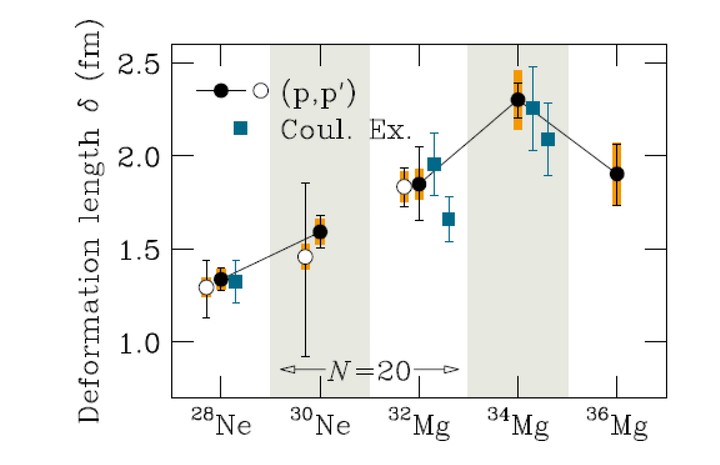Quadrupole collectivity in island-of-inversion nuclei $^{28,30}$Ne and $^{34,36}$Mg
 Cited from Phys. Rev. C
Cited from Phys. Rev. C
概要
The quadrupole collectivity of neutron-rich even-even neon and magnesium nuclei around $N=20$, $^{28,30}$Ne, and $^{34,36}$Mg, was studied via proton inelastic scattering on a liquid hydrogen target by in-beam $\gamma$-ray spectroscopy in inverse kinematics. The angle-integrated cross sections for the first $2^+$ states of these nuclei were determined by measuring de-excitation $\gamma$ rays. The deformation lengths were extracted from the angle-integrated cross sections using distorted-wave calculations. The deformation length of $^{30}$Ne ($\delta_{(p,p’)}=1.59^{+0.08}_{-0.09}$ fm) is smaller than that of $^{32}$Mg ($1.83^{+0.10}_{-0.11}$ fm), which exhibits the largest quadrupole collectivity among the neutron-rich $N=20$ isotones. Along the magnesium isotopic chain, the deformation lengths of $^{34}$Mg and $^{36}$Mg were deduced to be $2.30^{+0.09}_{-0.10}$ fm and $1.90^{+0.16}_{-0.17}$ fm, respectively. The evolution of quadrupole deformation in the vicinity of $^{32}$Mg is discussed by comparing the present results with the theoretical calculations.
Source: S. Michimasa et al., Phys. Rev. C 89, 054307 (2014).